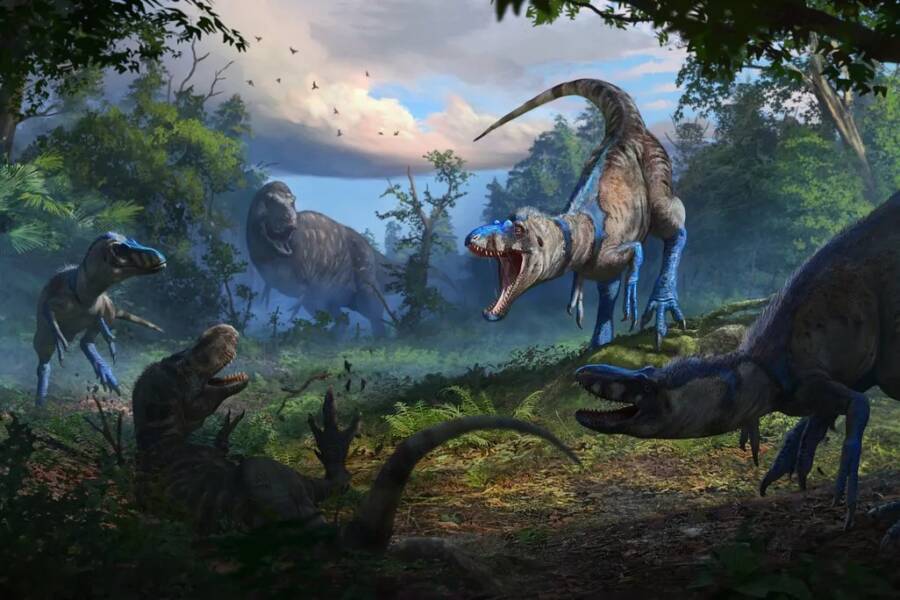In 1942, Paleontologists Uncovered What They Thought Was A Juvenile T. Rex. Now Its Been Identified As An Entirely Different Mini Tyrannosaur Species
Anthony HutchingsAn artists interpretation of Nanotyrannus lancensis.Recent research may have just settled a decades-long debate over whether a species that looked like a miniature Tyrannosaurus rex once inhabited the Earth. Paleontologists have long debated whether a fossil found in Montana in the 1940s and several similar specimens uncovered since then belonged to a juvenile T. rex or a separate species known as Nanotyrannus lancensis. Now, a paper published in Nature claims to have an answer: Nanotyrannus is real.The Enduring Debate About The Teen RexNorth Carolina Museum of Natural SciencesThe skull of Nanotyrannus lancensis.In 1942, paleontologists in Montana uncovered a dinosaur skull that they initially believed belonged to a type of tyrannosaur known as a Gorgosaurus. When another group of scientists took a closer look at the specimen nearly 50 years later, however, they concluded that it was actually from a Nanotyrannus lancensis.This sparked a heated debate, as other paleontologists insisted that the dinosaur was a juvenile T. rex. Then, in 2006, the Dueling Dinosaurs were unearthed. This remarkable fossil depicts a Triceratops fighting a tyrannosaur and it reignited the argument when scientists once again began debating whether that tyrannosaur was a young T. rex or a different species entirely.Now, a study published in Nature presents evidence that the Dueling Dinosaurs tyrannosaur along with the similar specimens found before it was indeed a Nanotyrannus lancensis.How Was The Nanotyrannus Different From The T. Rex?Researchers from the North Carolina Museum of Natural Sciences cut into the limb bones of the tyrannosaur found in 2006 to count its growth rings and determined that it was 20 years old at the time of its death, and thus completely mature. For that reason, it couldnt be a juvenile T. rex.A closer look revealed a number of differences between the two species as well. N. lancensis had longer forearms, more teeth, and fewer tail vertebrae than the T. rex. It also had a unique pattern of skull nerves and signs of a vestigial finger not present in T. rexes.Whats more, even the mature Nanotyrannus was significantly smaller than a T. rex. As study author Lindsay Zanno told Scientific American, Simply put, the Dueling Dinosaur Nanotyrannus is fully grown at half the length and one-tenth the body mass of a mature T. rex. There is no scenario in which this animal morphs into a T. rex.Researchers believe that the Nanotyrannus may have been part of the tyrannosaur lineage that split 100 million years ago. This study has larger implications than simply proposing the existence of N. lancensis, however. In a very real way, this discovery overturns decades of research on the growth and biology of Tyrannosaurus rex, Zanno told The New York Times. We have this animal thats been hiding in plain sight, and it raises all kinds of questions that we as paleontologists werent asking until now.However, other scientists are less convinced of the conclusion of Zanno and her colleagues. Thomas Carr, a paleontologist at Carthage College in Wisconsin who previously supported the juvenile T. rex theory, thinks the paper convincingly concludes that N. lancensis existed. However, he doesnt think that every similar specimen thats been found is actually a Nanotyrannus. [T]hen where are the juvenile T. rex? Carr asked. That part of the picture doesnt add up. While this may not be the end of the teen rex debate, the latest research has provide more evidence than ever before that Nanotyrannus once roamed the Earth alongside the T. rex.After reading about the Nanotyrannus lancensis, take a look at these 31 fascinating dinosaur facts. Then, discover terrifying prehistoric creatures that werent dinosaurs.The post In 1942, Paleontologists Uncovered What They Thought Was A Juvenile T. Rex. Now Its Been Identified As An Entirely Different Mini Tyrannosaur Species appeared first on All That's Interesting.


